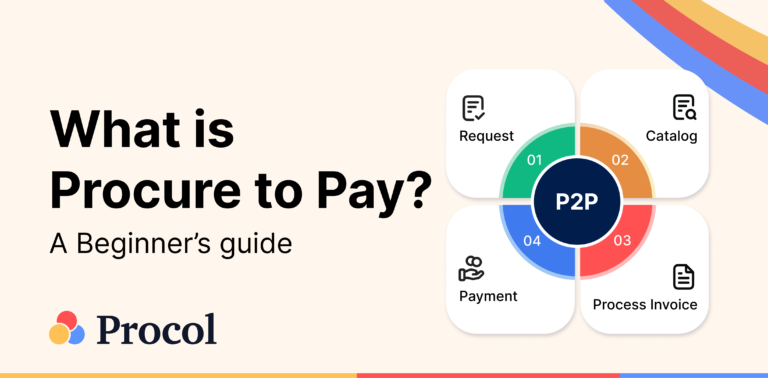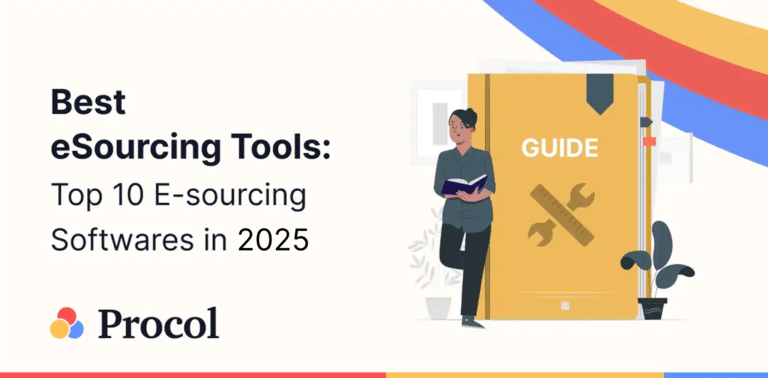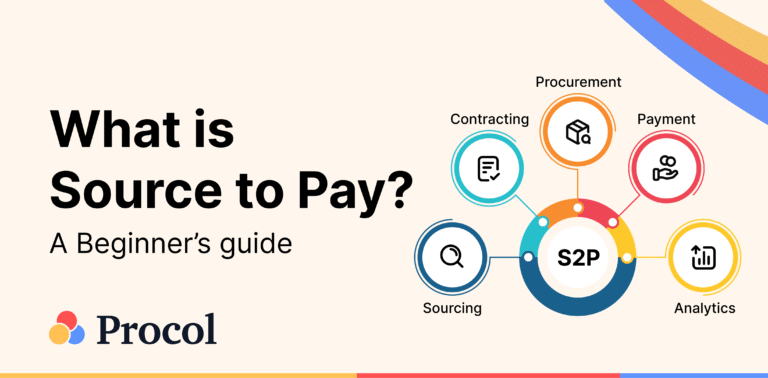Procol • April 15, 2025
A Guide to Common Procurement Terms and Abbreviations

When researching different topics in business, it’s easy to get confused by the industry-specific jargon and acronyms. Moreover, purchasing and procurement professionals use so many unique terms that it can be challenging to track them all. Understanding procurement terminology, abbreviations, and acronyms is integral to business success. In contrast, this can be difficult because of the different kinds of terms. If you spend some time learning key terms and abbreviations in the procurement process, you can be more successful in your business.
1. Auction Software: Auction software offers live monitoring of bids with context, real-time cooperation, and comprehensive purchase analytics.
2. Best and Final Offer (BAFO): BAFO refers to a multi-stage contracting process in which financiers request bidders and stakeholders to submit their best and final offers after receiving substantially acceptable bids and proposals.
3. Bill of Materials (BOM): This is a standard list of items required for manufacturing or assembling products. It tells a company precisely what is needed to manufacture a product or assemble a system.
4. Capital Expenditure (CAPEX): Capital Expenditure (CAPEX) refers to the amount of money put into an asset or business, including any additions, remodelling or refurbishing of property.
5. Category Management: It is the technique of grouping related items into a single category taking on all commercial objectives for that category. This aims to help users find relevant information quickly on their SERP.

6. Competitive Bidding: Competitive bidding is an online auction process in which online participants submit bids. Their bids are compared to other bidders, and the procurement department selects the high-value bid as the winning bid.
7. Contract Lifecycle Management (CLM): Contract lifecycle management simplifies and automates contract operations at critical points. The phases include the beginning, authorship, process and workflow, negotiating and approving, executing, continuing management and compliance, and contract renewal.

8. Direct Materials: Direct Materials are critical in industrial production as they are used to manufacture products, provide services, and assemble parts for small-scale manufacturing processes.
9. Dutch eAuction: Dutch eAuction is an internet auction platform built to make it easier for buyers and sellers to come together. It provides a low-cost solution for buying and selling assets.
10. eAuction: eAuction is a premier auction software for e-commerce business sellers that can be used to bargain and decide market prices for specific products.
11. eRFX: The word “eRFX” refers to procurement software that enables sourcing experts to request certain kinds of information to vet potential suppliers electronically. “x” stands for offer, estimate, data, or tender.
12. E-Invoicing: E-Invoicing is an effective approach to streamlining supply chain finance, invoice, and payment cycle.
13. E-Procurement: E-procurement is the strategy of buying goods and services electronically, without a face-to-face meeting between buyer and supplier.
14. First In First Out (FIFO): First In First Out is a part of inventory management and helps cut down on stock-outs due to new arrivals and older shipments being returned.
15. Group Purchasing Organisation (GPO): Group Purchasing Organisations are often contracted by large corporations to buy goods and services in bulk.
16. Inventory Management: Inventory management is the process of managing inventory by gathering and recording information about it. It involves planning and ordering, ordering, receiving, storage, distribution and replenishment.
17. Invoice-to-Pay (I2P): I2P is a type of software that allows invoice creation, tracking and payment.
18. Key Performance Indicators (KPIs): Key Performance Indicators are valuable means to measure the performance of a business.
19. Licensing: It’s the process of obtaining rights to use information, software, or other items for a limited time (with the option for renewal), usually in exchange for payment.
20. Logistics Management: Logistics management is the practice of managing the movement, storage, distribution and supply chain of materials, vehicles or other assets within a business enterprise.
21. Maintenance, Repair, and Operations (MRO): Maintenance, Repair, And Operations services offer businesses the ability to maintain their fleet of vehicles efficiently.
22. Maverick Spend: Maverick spending is described as purchasing from vendors violating the organisation’s approved procurement policy.
23. Operating Expenses (OPEX): Operating Expenses are the sum of all costs necessary to run an organisation. This includes business expenses, corporate management, purchases made for the company and employees’ benefits, etc.
24. Original Equipment Manufacturer (OEM): OEMs are companies that create products for other companies.
25. Payment Terms: Payment terms are an essential aspect of the relationship between you and your customers. It helps understand what is acceptable to customers concerning price and payment conditions.
26. Procurement Software: Procurement software is the core of supply chain management as a primary tool to control companies’ supply chains.
27. Procure-to-Pay (P2P): Procure-to-pay is an automatic invoice generation service that enables you to accept an order and generate an invoice within seconds.

28. Public Procurement: Public procurement is a process whereby the government acquires goods and services.
29. Purchase Invoice: This type of invoice is a reminder of the amount the buyer owes the seller.
30. Purchase Order (PO): A Purchase Order is a way to order goods, products or services formally.
31. Purchase Requisition (PR): Purchase Requisition is a form that must be submitted before a project or purchasing activity. It outlines the purpose and objective of the product/service, along with all available pertinent information you need before ordering.
32. Purchasing: The term “purchasing” refers to all of the operational duties of the purchasing department, such as determining needs, creating orders, requesting quotes, commissioning, and keeping track of delivery dates.
33. Request for Information (RFI): The Request for Information is an invitation to suppliers and other stakeholders. It asks them to submit a proposal and inform them about their capabilities, products and pricing.
34. Request for Proposal (RFP): Request for Proposal is a document that a prospective buyer issues to elicit proposals from potential sellers. It’s used to solicit competitive bids from prospective vendors and obtain information about them.
35. Request for Quotation (RFQ): Request for Quote is also defined as an Invitation for Bid (IFB). It is a procedure in which a business requests price quotations and bids from a chosen group of suppliers and contractors for the opportunity to carry out particular activities or projects.
36. Request for Tender (RFT): Request for Tender is a document issued by a contracting authority to registered bid holders, inviting them to submit their proposal according to the RFT’s conditions.
37. Reverse Auction: Reverse auction is a contract method that involves an auction process among bidders. It can be conducted at various stages of the procurement system.
38. Should Cost Model: The Should Cost model is a good way to help you determine the best price for your product or service.
39. Source-to-Pay (S2P): Source-to-Pay is a stealthy and powerful payment system that allows businesses to accept payments directly from suppliers.
40. Source-to-Contract (S2C): Source-to-Contract is a new approach to improving procurement solutions by aligning suppliers with projects.
41. Spend Analysis: Spend analysis can help businesses make well-informed investment decisions and save time and money during the decision-making process.
42. Statement of Work (SOW): A Statement of Work is a document that helps an organisation outline a project’s scope.
43. Strategic Sourcing: This is a fundamental business process that can help lower costs, increase profits and improve cash flow.
44. Supply Chain Management (SCM): Supply Chain Management is the process of optimising supply and demand for a product, material or service provided by organisations.
45. Tail Spend: The amount of money an organisation spends on purchases that account for 80% or so of all transactions but just 20% of the overall spend volume.
46. Third-party Logistics (3PL): 3PL is one of the essential functions of any business. It can help streamline inventory, lower logistics costs, and ensure that shipments are delivered on time.
47. Total Cost of Ownership (TCO): It is a cost estimate for the total price associated with the right of technology.
48. Total Quality Management (TQM): A quality management methodology aims to identify, prevent, and eliminate waste in the organisational process.
49. Vendor Management: Vendor management involves identifying vendors willing and able to provide product or service offerings that align with your company’s vision is necessary.
50. Warehouse Management System (WMS): WMS is a software application that automates warehouse management using computer applications and communication technology.
Procurement and purchasing terminology is crucial to the success of any company and can make a big difference in the success of a business. By properly understanding these terms, you can leverage the advantages of sourcing products and services from other companies.
Procol is a procurement software that eases the procurement system with digitisation and automation. Schedule a demo to understand just how flexible and user-friendly it is.
Explore more from Procol
Discover expert tips, how-to guides, industry insights, and the latest procurement trends.

What is Procure-to-pay (P2P)? An Ultimate Guide
Procure to pay is the process from procurement of materials needed...

Best eSourcing Tools: Top 10 eSourcing Software in 2025
Discover top 10 e-sourcing tools and esourcing platforms necessary for efficient...

What is Source-to-pay in 2025? An Ultimate Guide
Source to pay is the process of sourcing vendors to procure...











